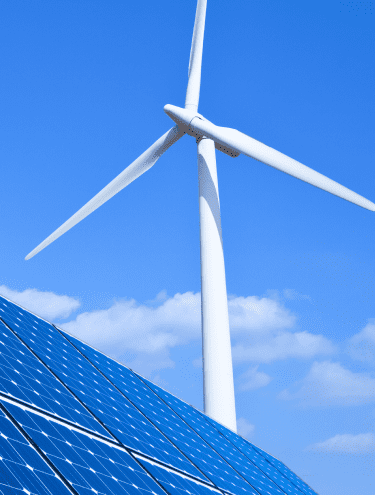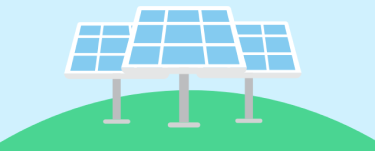




Make a commitment to using clean, renewable energy in your own life with a plan from Green Mountain Energy.
Types of renewable energy sources:


Solar Energy
The big, bright and beautiful ball lighting up the sky could supply the entire world’s energy needs by itself Solar energy takes all the awesome light the sun gives off for free and converts it into clean electricity for homes and businesses.
If you were able to collect all the sunlight that hits the Earth in one hour, you could generate enough electricity to supply the entire world for a year If that sounds wild, wait until you hear what we’ve been able to achieve with renewable solar energy already:
- Every megawatt hour (MWh) of U.S. solar energy avoids roughly 1,500 pounds of carbon emissions per year.3
- Green Mountain Energy customers help grow demand for solar energy, leading to increased solar electricity
- Through Green Mountain Energy Sun Club, we have funded solar energy projects that have empowered communities to live more sustainably.


Wind Energy
Human beings have been harnessing the wind for hundreds of years for everything from travel to producing food, but nowadays we capture wind for another reason: to sustainably power our homes and businesses.
If you’ve ever driven through agricultural areas, you’ve probably seen wind turbines spinning on the horizon. These giant three-bladed towers are a far cry from the old-school windmills that Don Quixote used to tilt at, but they also do much more. As of 2018, each MWh of wind energy generated across the United States avoids more than 1,400 pounds of carbon dioxide emissions per year.3
When you realize that the U.S. alone has the capacity to generate more than 105,500 megawatts (MW) of wind power,5 the benefits of renewable wind energy speak for themselves.
- Green Mountain Energy supports more than 100 wind farms right here in the U.S.
- Our customers help grow the demand for 100% wind energy.
- Wind energy is the fastest-growing job market in the U.S.4
Make a commitment to using clean, renewable energy in your own life with a plan from Green Mountain Energy.


Geothermal Energy
If you’ve never heard about geothermal energy before, get ready to be astounded. That’s right, you can source clean, renewable energy by harnessing heat from the center of the Earth.
The Earth’s core is hot. Really hot. We’re talking hotter than the surface of the sun. If you drill a hole deep enough, you can capture some of that heat in the form of steam. Funnel that steam through a turbine that rotates a generator, and the next thing you know, you’re sending 100% pollution-free electricity out to homes and businesses.
- Geothermal energy helps the U.S. avoid more than 1,500 pounds of CO2 emissions for every MWh generated each year.3
- More than 20 countries generate geothermal energy today, with California and Nevada leading the way in U.S. geothermal power generation.
- By 2023, global geothermal power capacity is expected to exceed 17 GW.6 That’s enough electricity to power more than 1,500 homes for a year!1
Sounds steamy, doesn’t it?


Hydroelectricity
While solar and wind energy have received some much-needed hype in recent years for all they’re doing to help the planet, there’s one renewable energy source that’s been churning out clean electricity for a long, long time: good old trusty H2O.
Hydroelectricity – aka hydroelectric power, or hydropower if you’re a cool kid – is generated using the power of moving water in rivers and oceans. It’s such a popular source of clean energy that every state in the U.S. uses it to some degree. In Washington state, for example, hydroelectricity is responsible for 70% of all the electricity used!
- Evidence of hydropower has been found as early as 350 BC, making it one of the oldest power sources in human history.
- Many forms of water can be harnessed to make electricity, including river currents, river dams, ocean waves and ocean tides.
- Hydroelectricity avoids more than 1,500 pounds of carbon emissions per MWh in the U.S. every year.3
To create hydroelectric power, you build a dam that directs flowing water through a pipe to a turbine before spitting it back out on the other side. The force of the water going through the pipe spins the turbines, which rotate a generator that produces electricity.


Biomass Energy
Human beings have been harnessing the wind for hundreds of years for everything from travel to producing food, but nowadays we capture wind for another reason: to sustainably power our homes and businesses.Ever roasted marshmallows at a campfire? Then congratulations, you’ve enjoyed the benefits of biomass energy. Biomass is a fancy term for any organic matter that releases energy when it’s burned or decomposed. The most common biomass used in renewable energy comes from plants, food waste and animal waste.
It works like this. Plant-based biomass like wood scraps, sawdust and excess crops is burned to create steam. Animal-based biomass like waste from farm animals is collected in a large tank with bacteria to produce methane, which is then burned to heat water and create steam. In both cases, the steam spins a turbine to power a generator, and electricity is sent out to the grid.
- Green Mountain Energy customers support biomass electricity generation right here in the U.S.
- Biomass energy used by Green Mountain Energy customers diverts excess crops, sewage sludge and organic trash away from the waste stream.
Biomass as a renewable power source is one of the ways to put waste products to good use in the clean energy business. It’s true what they say: one person’s trash is another person’s source of renewable clean energy.
Make a commitment to using clean, renewable energy in your own life with a plan from Green Mountain Energy.
1U.S. Energy Information Administration
2Impact statistics based on a Texas home using 2,000 kWh per month and an annual car mileage of 15,000.
3Environmental Protection Agency
4Bureau of Labor Statistics
5American Wind Energy Association
6International Energy Agency
Our customers have avoided
pounds of CO2
That’s like planting
new trees.